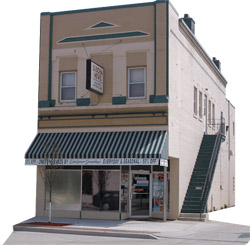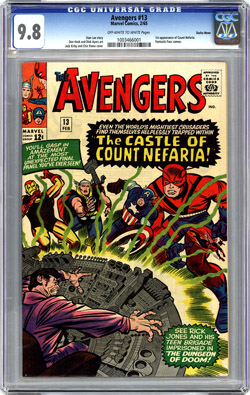Suscha News Collection!
Posted on 11/9/2010
Over the past 30 years, there have been a number of important pedigree collections brought to the comic-collecting public. After you read this article, you will see that another is about to make news!
Better than any description I can put together is the story of the collection that comes from the original owner himself. However, before you read his story, let me say that I have been waiting for more than 13 years to find this collection. Why 13 years? That is when I found the Oakland Collection, which by many collectors’ accounts is one of the finest collections ever found of late-60s to mid-70s comics. Over the past 13 years I have fielded thousands of calls and purchased hundreds of collections from people with what they deemed “never-opened and mint-condition comics.” Sadly, those comics usually failed to live up to the condition I was hoping for, until that is the Suscha (pronounced Susha) News Collection. What makes the collection so special is not only the fact that the books are in overall spectacularly high-grade condition, with very rich inks and gloss and reflectivity that is so high it hardly makes sense, but that the books go back to the mid-1960s and all the way up to 1976, therefore actually surpassing the Oakland collection in both its beginning and end dates.
Vincent Zurzolo, COO
Metropolis Collectibles, Inc.
The Story of the Suscha News Collection in the words of the original owner:
There’s a big empty corner in my house. A few weeks ago, 50 boxes dominated the largest room in the downstairs level. Now they’re gone, shipped to Metropolis Collectibles in New York City. Those boxes represented almost half a century of toil and worry, dragging 1,200 pounds of fragile paper along with me as I moved from Wisconsin to Arizona to Idaho. Humidity, roof leaks, mold, fire, insects and burglars always were on my mind.
I didn’t start out as a “comic collector.” Born in 1949 and growing up in Sheboygan, Wis., in the 1950s and ’60s, I was the kind of fastidious child who always used the kickstand on his bike and dusted off his model cars and planes every Thursday afternoon without fail. Because I treated my few possessions well – and had no brothers or sisters to help destroy them – I tended to accumulate things, including comic books.
My early favorites were war comics: DC titles like Our Army at War and Our Fighting Forces. Superhero comics didn’t appeal to me at all – that is, until a friend introduced me to Marvel in 1963, when I bought about a dozen comics from him for five cents apiece. These included Amazing Fantasy #15 and Fantastic Four #5!
I dug the real-world settings, character development and snarky humor of these Stan Lee creations, and began to buy every Marvel title I could find. By the time I finished high school in 1968, I’d amassed about a thousand comics, which had outgrown their place in dresser drawers and moved to shelves in a closet.It was around this time that I began to think of myself as a “comic book collector.” Most of the titles were exciting works of art and imagination, and some were epic in scope, especially my favorites: Thor, Doctor Strange, The Fantastic Four, Spider-Man and Sgt. Rock. Stan Lee, Jack Kirby, Joe Kubert and Steve Ditko will always be the “Big Four” in my book.
By 1970, I was married and in my own place, although the comics remained in my parents’ house, relocated to the basement. After a few close calls with relatives rifling through the collection for poolside reading and even a threat to burn it all, I bought dozens of boxes and moved everything to a duplex I was renting. Over the next 20 years, I would move nine times, and the comics were always the heaviest, most delicate and time-consuming items in my household.
Although comic books were only 15 to 25 cents each at the time, buying more than a hundred a month represented a big chunk of my tiny, $3-per-hour paycheck. The books were mainly purchased at newsstands and drug stores. It was about this time that I got the idea to go directly to the local magazine and comic distributor, Suscha News (founded in November 1937), and propose a deal.
 |
|
| Suscha News, Sheboygan, Wis. | |
I explained to them how many comic books I bought on a regular basis, and how I’d buy a lot more if the prices were lower. To my surprise, they agreed to sell me newly arrived comics at half price off the pallets in their back room. This gave me access to the books as soon as they arrived in Sheboygan, so l was more likely to get certain low-distribution titles. I also got to “cherry-pick” books, and my comics from then on were free of shelf wear from browsers. I would carefully go through distributor boxes filled with the same issue of a book. I’d get it down to around a dozen or so mint copies of a given book to try to find the MOST mint copies in the group. I was looking for books with the best centering, the shiniest staples, the flattest covers and the sharpest top and bottom of the spine.
Now that the cost of buying comic books was cut in half, I also was able to buy multiple copies of each. Sometimes, I’d get a half-dozen or more copies of Number One or milestone issues, such as Thing vs. Hulk matchups. My arrangement with the distributor lasted until 1976, when I decided to give up the comic book buying and boxing grind, and “lock” the collection. I bought very few comics after that – a few hundred at most.
In 1978, I moved to Tucson, Arizona, and two years later was in a new home with a special feature – a large, fireproof, walk-in vault big enough to accommodate the comic book collection, which by now took up a 6-foot-wide by 5-foot-long by 6-foot-high stack. Property crimes, particularly home burglaries, are a major problem in southern Arizona, and the vault seemed a necessity to protect my comics, guns, cameras and other valuables. The arid conditions of Arizona were a godsend for storing comics.
It was now the early ‘80s. My wife at the time often tried to pressure me to sell the collection. In those days before blockbuster movie franchises based on comic books and the Internet, the books were worth a tiny fraction of what they bring today. Had I caved in and sold then, I literally would have realized just enough money to buy a used pickup truck, which would have gone to the scrap yard years ago.
Over the years, I kept track of the collection with a big piece of graph paper, about five feet long by three feet wide. This pencil-and-paper record somehow disappeared over the years, so in 1998 I cataloged everything in an Excel spreadsheet and repackaged each comic book in a poly bag with a backing board. I put the bagged and backed comics back into the 1976 boxes.Two years later, we moved to the woods of North Idaho, far from the desert of southern Arizona. The climate here is relatively dry and crime is very low, but I missed my big secure vault. The comics were kept on industrial shelving in a large room in the lower level of the house, where I kept humidity in the mid-40 percent range with a dehumidifier. The collection was “hidden in plain sight” by turning the contents labels of each box toward the wall, and placing fake “Professor Owl Remedial Reading Workbook – Grade 5” labels on the visible side. I figured no burglar would be interested in stealing a half-ton of identical teaching aids.
When I reached 60 years old, I seriously began to consider selling the collection. I didn’t want to end up the guy with the most comic books in the graveyard. There were lots of things I could do with the money the collection would bring. Because there were so many books – and none of them were CGC-graded - contacting a large comic dealer seemed the best and most realistic way to sell them. I talked to several dealers, eventually going with Vincent Zurzolo of Metropolis Collectibles in New York City. He offered to pay to ship the collection to New York, and if we couldn’t reach a deal, would ship them back, or he could come all the way out to the wilds of Idaho and examine it in person. I didn’t want the comics to move so far out of my control, so we went with the second option.
 |
|
| The first book from the Suscha News Collection graded by CGC. |
|
It was more than two months from my first contact with Zurzolo to the day of his arrival in Idaho. I spent that time un-boxing and re-bagging every comic, checking them against the inventory on my spreadsheet. To my horror, I found most of the “archival” bags I used back in 1998 had wrinkled and needed to be replaced. Fortunately, the wavy wrinkles didn’t imprint on the comics inside. I also placed the comics in new boxes, replacing the ones they had been stored in since 1976. Mr. Zurzolo spent more than a day looking at the comics, making notes. When I would check on his progress every few hours, he’d explain how he was evaluating various issues. After a short negotiation, I arrived at an agreement with Mr. Zurzolo. We then spent half a day preparing the collection for shipment. He took about 75 of the most valuable books in his carry-on backpack for the flight home to New York City. Now that they’re gone, I feel easier leaving the house for extended periods. Pretty much anything I owned was replaceable – except for my old comic books.
As I re-bagged the comics this year prior to selling them, I couldn’t resist reading my favorite stories again. I was struck by how those thousands of issues made up an impressive heap of imagination and creativity: More than 100,000 pages of storytelling and art from some very talented people who often didn’t get the respect and financial reward they deserved. There was a defining moment for me in the whole process of negotiating a deal and packing and shipping the collection. Mr. Zurzolo and I worked for five hours, tightly packing each short comic box and securely padding and taping each one. At one point, he ran out of space to sort the stacks of comics, even though we were working on several large tables. I started to take a bunch of comics into an adjacent room, to free up some table space. Mr. Zurzolo saw what I was doing and sprang up to quickly take them out of my hands – the same hands that had nurtured and coddled those fragile books for more than 40 years. But I understood what he was thinking. “They’re my comics now,” he said. And they were.
"The story of the Suscha News Collection from the original owner himself is a great one. The first batch of books to come back from CGC from the Suscha News Collection will be offered to the comic book community in the ComicConnect.com Event Auction beginning November 10. Having viewed each and every one of these books firsthand, I believe this is going to be one of the most well-received pedigrees from this time period to hit the comic market,” stated ComicConnect.com COO Vincent Zurzolo
This is a guest article. The thoughts and opinions in this piece are those of their author and are not necessarily the thoughts of the Certified Collectibles Group.
Stay Informed
Want news like this delivered to your inbox once a month? Subscribe to the free CGC eNewsletter today!